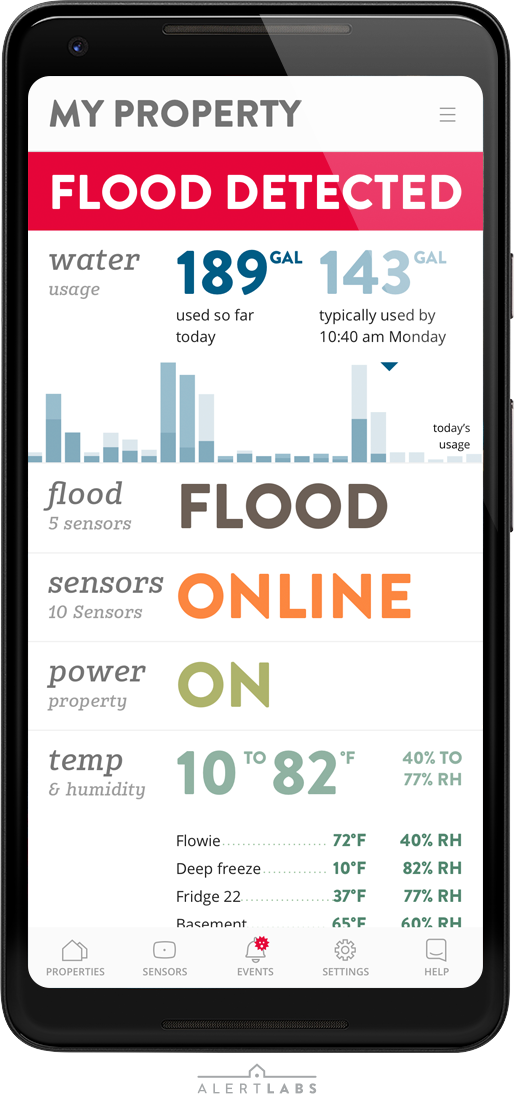Property damage caused by water related events accounts for the largest proportion of emergency calls to property restoration companies. Whether due to a sudden weather event or a slow undetected leak, the impact of unmitigated water damage can be a costly disruption to any business. When left unattended, impacts are more substantial as it can lead to harmful mold growth, structural degradation, health risks, business interruption and higher remediation costs.
Environmental & sustainability goals are an increasingly critical aspect of our business practices. Building managers are challenged with finding ways to conserve energy and natural resources, reduce emissions and increase efficiencies among other sustainability goals.
Developments in IoT have given rise to technology solutions that enable businesses to be more proactive in dealing with a variety property management needs and challenges. Water monitoring proptech, or property technology, enables facility managers to monitor water usage, temperature and/or humidity to detect abnormal conditions quickly, better preparing them to address issues and mitigating damage. Monitoring water consumption is another means toward reducing losses and increasing environmental sustainability practices. This article answers some key questions about how businesses can prevent and mitigate water damage and monitor water consumption using technology-based solutions like Alert Labs.
- How the technology works
- Where to install the technology
- The benefits of adopting the technology

How Water Monitoring & Leak Detection Technology Works
A water intelligence platform with cellular-connected devices provides minute-by-minute water usage insights and 24/7 emergency alerts. These devices are smart programmable sensors that can track unusual patterns in water consumption. A leak detection device, also called a leak sensor, will bring attention to a situation when it encounters water unexpectedly and quickly alert the appropriate responders via phone, text, or email in case of emergencies.
The programmable sensors are placed strategically in key areas of a facility and feed data into a central dashboard for easy viewing. The continuous data capture allows for machine learning to develop specific algorithms identifying water consumption patterns, including unusual water use. The information collected can then be utilized to focus on areas for improved efficiencies.

Where To Install
Whether brand new or decades old, the technology can support any site across all industries. Water monitoring and leak detection devices can be installed in virtually any location. The best devices can be installed quickly without intruding on a building’s current infrastructure. The sensors are typically placed in high-risk, high production and sensitive areas depending on the type of facility.
Areas with exposed or concealed pipes such as in restrooms, kitchens, cafeterias and staff break rooms are potential risk zones due to frequency of usage. Additional vulnerable areas include unattended spaces and storage areas where water and moisture can accumulate undetected and cause flooding and/or mould. Similar risks exist in mechanical rooms, near cooling systems, heat pumps, fire sprinkler lines among others.
Protect, Save & Sustain
Mitigating the risk of water damage is paramount to maintaining normal building operations. Fortunately, there are smart technologies to support these preventative measures. Today’s technology solutions offer real-time and remote water usage monitoring and analytics to achieve better protection, insights, and control.
Using the available “tech tools” helps with early identification of water damage and gives building stewards a better chance at protecting their assets. The technology also gives facility managers and property management a chance to monitor potentially harmful water activity in real time and better coordinate a response when it’s needed. Leak detection aides in getting resources to site more efficiently which further reduces impact of losses.
“The sooner you can respond to water damage, the better,” says Brendan Murphy, Vice President, National Accounts at First Onsite Property Restoration. “That’s why the best systems are those that alert the right people to problem areas quickly so that you can avoid costly remediation, longer disruption to services and increased operational costs and efforts.”
The increased visibility and data into your water usage will help your properties operate more cost effectively with reduced inefficiencies, improved sustainability and be better prepared when the unexpected happens. Data garnered from these technologies produce reports and graphs that helps benchmark water consumption across an entire portfolio, uncover pattern predictions, anomalous trends, and opportunities for better efficiency. The data also helps with:
- Prioritizing water management, maintenance & repairs
- Comparing water use across your entire portfolio to help benchmark and evaluate building performance
- Forecasting water costs before receiving water bills

Measure Water-Related ESG Goals
“The technology does more than bring attention to potential emergencies; it provides a continuous flow of real-time water usage data that enables building teams to see where they’re using the most water and where they need to take appropriate steps,” adds Murphy.
Water monitoring technology allows for improved water conservation efforts that contribute to overall ESG goals. Reduction in water consumption also means reduced spend in water consumption. Every drop of water flowing through buildings requires energy to be treated, distributed, pumped, and heated. Organizations can lower the CO2e emissions associated with this embedded energy by detecting and resolving water inefficiencies faster.
Interested in getting your business setup with leak detection technology? Give us a call today.
